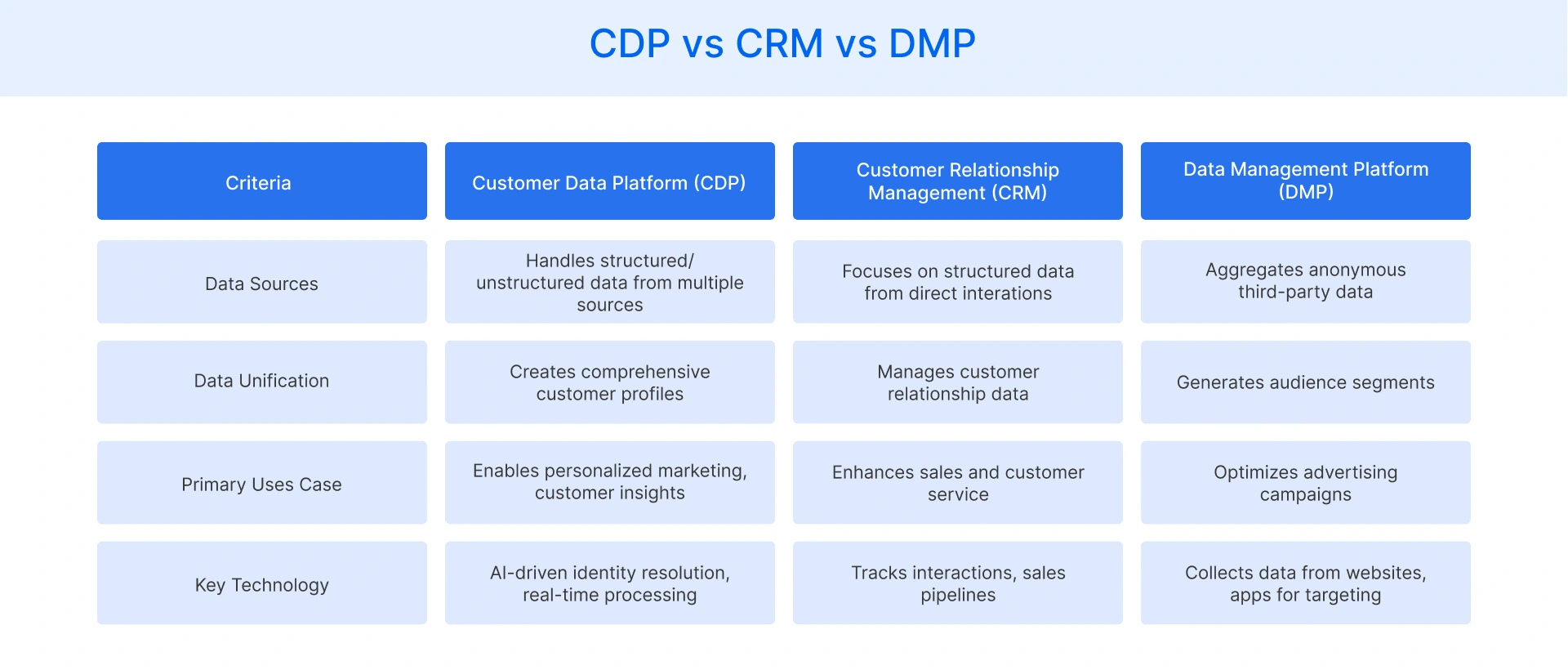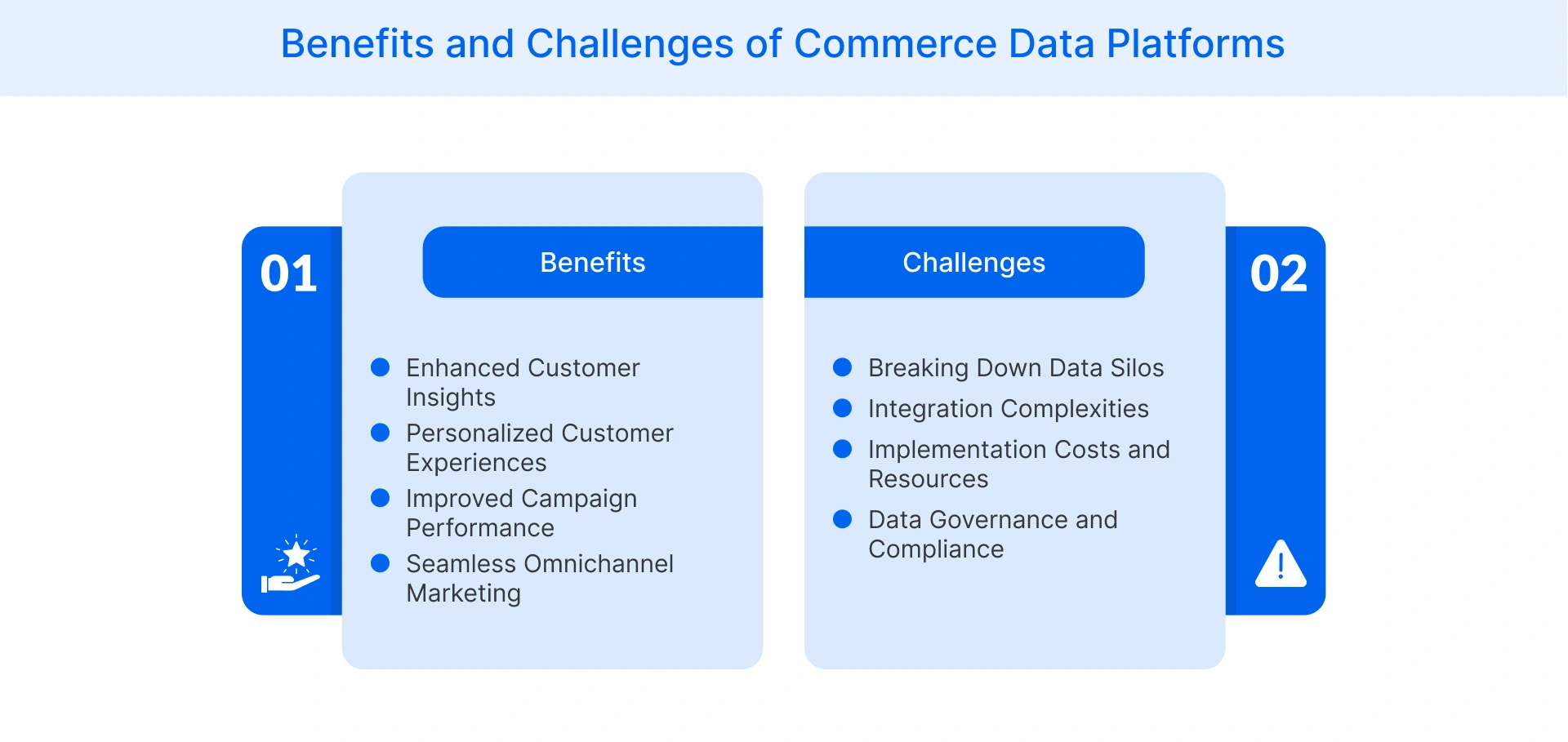Table of Contents
- What is a Customer Data Platform?
- Key Components of a Customer Data Platform
- Customer Data Platform vs. CRM vs. DMP
- How a Customer Data Platform Works?
- Benefits of Using a Customer Data Platform
- Challenges of Implementing a Customer Data Platform
- Use Cases of Customer Data Platforms
- Conclusion
What is a Customer Data Platform?
A customer data platform (CDP) is a centralized system that collects, organizes, and unifies customer data from diverse channels, including websites, mobile apps, email campaigns, and offline transactions. This unified customer database creates a comprehensive, single view of each customer, enabling businesses to deliver targeted marketing, personalized experiences, and data-driven decision-making.
Unlike traditional data management systems, CDPs integrate first-party, second-party, and third-party data, ensuring that all customer interactions are captured in real time. This unified approach to customer data management empowers companies to understand user behavior, preferences, and purchase patterns, facilitating more effective engagement strategies.
Key Components of a Customer Data Platform
A company’s customer data platform relies on several core components that work together to offer actionable insights.
Identity Resolution and Customer Segmentation
CDPs use advanced algorithms, including deterministic and probabilistic matching, to unify multiple user identifiers into a single unified customer profile. By analyzing data from websites, mobile apps, and offline transactions, CDPs consolidate fragmented information into an accurate customer view. This enables precise segmentation, allowing businesses to target customers based on behaviors, preferences, and demographics.
Real-Time Data Processing and Storage
Real-time data processing ensures that customer profiles remain updated as new information flows in from various touchpoints. Cloud-based storage provides the scalability required to handle large datasets while maintaining fast access to customer insights. This real-time functionality allows businesses to react promptly to customer behaviors, improving engagement and personalization efforts.
Privacy Compliance and Data Security
CDPs prioritize data privacy and security by adhering to regulations like GDPR and CCPA. They employ encryption protocols, access controls, and consent management features to protect customer information. This ensures that businesses can maintain trust while leveraging customer data for marketing and analytics purposes.
Customer Data Platform vs. CRM vs. DMP
While Customer Data Platforms (CDPs), Customer Relationship Management (CRM) systems, and Data Management Platforms (DMPs) all handle customer data, they serve distinct purposes.
A CDP is designed to collect, organize, and unify customer data from multiple sources to create a single, comprehensive customer profile. It excels in real-time data processing, identity resolution, and ensuring data privacy compliance.
Conversely, CRM systems focus on managing direct interactions with customers, such as sales, customer service, and support activities. They track customer interactions, sales pipelines, and communication history to enhance customer relationships and drive sales efficiency. Unlike CDPs, CRMs primarily store structured data and cannot handle large volumes of unstructured data from diverse sources.
DMPs collect and manage data related to online advertising and audience targeting. They aggregate anonymous data from various sources, such as websites and apps, to create audience segments for targeted advertising campaigns. Compared to CDPs, DMPs focus on third-party data and are limited in their ability to provide detailed customer profiles.

How a Customer Data Platform Works?
A customer data platform operates through a structured process that involves collecting, unifying, and activating customer data.
Data Collection and Integration
A CDP Platform aggregates data from various touchpoints, including websites, mobile apps, email campaigns, and in-store transactions. This integration ensures that all customer interactions are captured, providing a holistic view of the customer's journey. By consolidating diverse data sources, CDPs enable businesses to track customer behavior accurately. This helps marketing teams to identify trends and tailor their strategies to meet customer needs effectively.
Customer Profile Unification
CDPs merge fragmented data points to create a comprehensive 360-degree view of each customer. By unifying data from multiple sources, they generate accurate and detailed customer profiles, allowing businesses to understand their customers better and tailor their strategies accordingly. This holistic approach ensures that all relevant information is available in one place, offering a single customer view and facilitating informed decision-making and personalized interactions.
Data Activation for Marketing and Personalization
CDPs enable businesses to leverage unified data for targeted marketing campaigns, personalized experiences, and predictive analytics. By activating this data, these platforms empower marketers to deliver relevant content and offer to the right audience at the right time, enhancing customer engagement and driving conversions. The ability to use comprehensive customer profiles allows for more precise segmentation and improved marketing ROI through tailored campaigns and predictive insights.
Benefits of Using a Customer Data Platform
Customer data platforms offer numerous advantages that can significantly enhance your marketing efforts and improve customer relationships:
- Enhanced Customer Insights: By unifying data from various sources, CDPs provide a comprehensive view of your customers. This 360-degree perspective enables you to understand customer preferences, behaviors, and journeys across all touchpoints. This assists with informed decision-making and targeted strategies.
- Personalized Customer Experiences: With access to detailed customer profiles, you can deliver highly personalized experiences across all channels. CDPs enable you to tailor content, product recommendations and offers based on individual preferences and behaviors. This helps increase engagement and customer satisfaction.
- Improved Campaign Performance: CDPs empower you to create more effective marketing campaigns through precise audience segmentation and targeting. By leveraging unified customer data, you can develop highly relevant messages and offers. This results in higher conversion rates and improved ROI on your marketing investments.
- Seamless Omnichannel Marketing: CDPs facilitate consistent customer experiences across all channels by centralizing data and enabling coordinated marketing efforts. This unified approach ensures that your customers receive coherent messaging and personalized interactions, whether they are engaging with your brand online, in-store, or through mobile apps.

Challenges of Implementing a Customer Data Platform
While CDPs offer significant benefits, implementing them can present certain challenges:
- Breaking Down Data Silos: Many organizations struggle with data fragmentation across different departments and systems. Integrating these siloed data sources into a CDP requires careful planning, cross-departmental cooperation, and potentially significant changes to existing data management processes.
- Integration Complexities: Connecting a CDP with your existing marketing automation systems can be complex. You may face challenges in ensuring seamless data flow between various marketing systems, maintaining data quality, and reconciling different data formats from diverse sources.
- Implementation Costs and Resources: Implementing a CDP often requires substantial investment in terms of time, money, and personnel. The costs associated with software licensing, data migration, staff training, and potential system upgrades can be significant, especially for smaller organizations.
- Data Governance and Compliance: With the increasing focus on data privacy, ensuring compliance with regulations like GDPR and CCPA can be challenging. Implementing proper data governance practices, managing customer consent, and maintaining data security within your CDP requires ongoing attention and resources.
Use Cases of Customer Data Platforms
Here are some key use cases of CDPs:
- Omnichannel Personalization: CDPs enable businesses to create consistent customer experiences across multiple touchpoints. By unifying customer data, businesses can deliver personalized content and offers, ensuring a seamless experience regardless of the channel. At Flipkart Commerce Cloud, our Composable Storefront solution enhances omnichannel personalization by providing adaptable shopping experiences that respond to customer preferences.
- Predictive Analytics and AI-driven Insights: AI-powered CDPs forecast customer behaviors, helping businesses optimize marketing spending and product recommendations. Predictive analytics driven by technologies like machine learning and artificial intelligence enable companies to anticipate customer needs and tailor their strategies to maximize impact.
- Customer Journey Optimization: CDPs analyze customer behavior to enhance journey mapping and engagement strategies. By understanding how customers interact with different touchpoints, businesses can optimize their marketing efforts to improve customer satisfaction and loyalty. At FCC, our Omnichannel CRM integrates seamlessly with CDPs, enabling businesses to communicate effectively across channels and improve customer engagement throughout their journey.
- Data Privacy and Compliance Management: CDPs assist in ensuring compliance with data privacy regulations and efficiently managing customer consent. By centralizing customer data, businesses can streamline compliance processes and ensure data security.
Conclusion
Customer Data Platforms (CDPs) play a vital role in helping businesses centralize customer data, enhance customer experiences, and drive marketing success. By leveraging unified customer profiles, businesses can deliver personalized content, optimize marketing strategies, and ensure compliance with data privacy regulations. CDPs empower retailers to stay competitive in an increasingly data-driven market, improving overall efficiency and customer satisfaction.
FAQ
A CDP helps personalize customer experiences by providing a comprehensive, real-time view of each customer. It consolidates data from multiple touchpoints, enabling you to understand individual preferences and behaviors. This insight allows you to tailor product recommendations, content, and offers across various channels, creating more relevant and engaging interactions that resonate with each customer's unique needs and interests.
Customer data platforms improve marketing ROI by enabling more targeted and efficient campaigns. They provide a unified view of customers, allowing you to create highly segmented audiences for personalized marketing efforts. CDPs also help in identifying high-value customers, optimizing campaign timing, and reducing wasted ad spend through better audience targeting and predictive analytics.
A customer data platform can collect a wide range of data types from various sources. This includes demographic information, behavioral data from website interactions, purchase history, social media activity, email engagement metrics, customer service interactions, and even offline data from in-store visits. CDPs can also integrate third-party data to enrich customer profiles.

